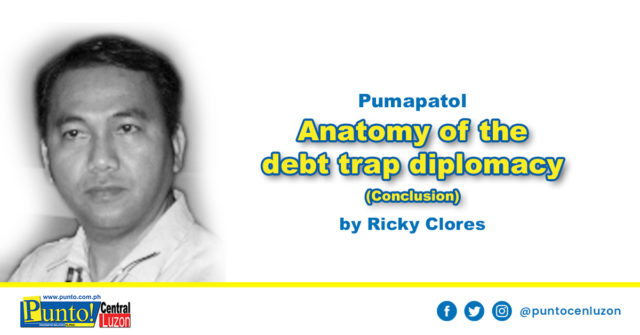THERE ARE several characteristics of these debt-trap as far as the global community is concerned: (1) the lending of large, almost unbelievable amount; (2) inability of the country to pay back; (3) if the country is unable to pay back its loan, China will take over if not expect to horde an important resource(s) of that country; (4) directed mostly to the construction of monolithic structures; and the (5) deployment of Chinese material and human resources.
Sri Lanka is a case in point in these five debt-trap characteristics. When Sri Lanka took the bite of developing the Hambontota Port structure via a China debt deal, it did not consider if the project would actually be viable, thus the tragic ending. The Hambontota Port is now under the control of China and the country is forced to a 99-year lease deal. During the construction, the Chinese engineers and labor force descended to the country. And because at the end of all these deals Sri Lanka is 70 billion dollar in debt to goliath China, 95 percent of the country’s revenue would be used to pay this loan.
However, Sri Lanka is not alone in this unfortunate debt-trap. In Vanuatu, another cashstrapped country in the South Pacific, China pumpedin money to build a ridiculously useless gigantic stadium and a convention center. The Chinese descended in full force to build these monolithic structures. Not satisfied, China built half a kilometer wharf supposedly for commercial purposes, but is large enough to host a naval force. The total cost of the Vanuatu debt-trap is a whopping $220 million. As expected, small Vanuatu cannot pay back. And the rest, as expected, is China control.
Countries like Pakistan, Montenegro, Maldives, Djibouti, Angola, Ethiopia, Kenya, Republic of the Congo, Malaysia, Myanmar, Fiji and Sudan share similar tragic deb-trap stories, specifically the building of these ludicrous, economically unsustainable and monolithic structures, and the eventual inability to pay back. The narrative is clear: the initially sweet and almost unbelievable huge China loans would eventually turn bitter in the end, with one country getting mostly if not all of the upper hand.
But, this is not to say that all the fault lines and rebuke fall on the Chinese side. If we do, this will not only be unfair to China, but is essentially committing a simplistic analysis. The governments which took the loans hook and sinker are also to blame. When PM Mahathir Mohammad of Malaysia, for example, warned us of the onerous goliath China debt trap, the criminal case against the corruption of former Malaysian PM Najib Razak is already rolling. Most if not all of the said corruption issue thrown to Najib is traced to the China debt loans. Of course, we know that Mahathir complained of the thousands of Chinese workers, the heavy dependence on Chinese materials, and the limited opportunities of local companies that descended to Malaysia during the construction of the gigantic railroad, but we cannot dismiss the fact that the corrupt management that the Najib leadership inserted into the China loan was the debt deal’s most vicious reason for its sorry failure.
In the end, the debt-trap is not a one-way street. Note that a deal is still a negotiation and would mean that there are at least two parties involved. Each party is expected to protect its interest. Each party, whether you are a lender or a borrower has the right to walk out. And ideally, once the deal is sealed, each party is expected to be responsible and accountable.
However, looking at the world’s debt trap records, between and among the semantics of debt, trap and diplomacy, the one that carries the most weight is actually diplomacy. China’s Xi Jinping and his cohorts in the government are showing us, nay the world, the highly strategic, the most precise, the most calculated and the most informed expertise in commanding the world’s economic stage.
The Chinese government’s knowledge of the needs for economic investment of the mostly small and developing countries of the world and the Chinese government ability to eventually exploit this niche, disadvantage or opportunity, if you may, to China’s advantage is indeed ingenious and to a larger extent unprecedented in this modern times. The Belt and Road Initiative is undeniable sample of the scale, the kind and the quality of China’s global economic management of and to the world. The usual economic players, like the US, Australia, England and France can either sound the alarm or eventually succumb to join the bandwagon.
Moreover, this diplomacy is characteristically replete with “double talks”. While China is espousing its preferred bilateral engagements, as against international arbitration, in territorial and economic disputes, it does not only act and behave with very limited restrained, but breaks all rules along the way. The supposed status quo position/agreement on the West Philippines seas while bilateral talks are transpiring between goliath China and Philippines is the glaring sample. Today, the disputed areas of the West Philippines Seas are already littered with economic and military structures while bilateral talks with goliath China are on-going.
And when pushed to the wall, like what happened to the Hague resolution favoring the Philippines to its territorial claims in the West Philippine seas, China chooses to reject the decision and immediately reverts back to its selective posture towards international rulings.
This brings the question to us: What is the state and quality of the Duterte diplomacy, specifically towards goliath China? If we are to take Senator Panfi lo Lacson’s observations, the Duterte diplomacy is “defeatist” to say the least. The Duterte government looks at strength and persuasions as merely reduced to fire and military power. Thus, the constant reminder to all of us that we do not have the armed capabilities to match goliath China. President Duterte’s recent pronouncement is uninspired, that if China decides, the whole military capability of the country can be pulverized in matter of minutes, and if China sends the scary missile from Beijing, Manila will be wiped out in seven minutes.
While pummeling the country with the its military incapability, the Duterte government refuses to recognize, work on, and exploit its identified strengths: the favorable Hague decision, the persistent and consistent diplomatic protests in all possible venues and platforms available, the strong and historical alliance with the US and to a large extent Japan, and most importantly, the resolve and resilience of the Filipino spirit.
Indeed, if we take the semantics of debt, trap or diplomacy, the two-way street perspective works. The debt trap diplomacy as a global narrative is not only about goliath China as it is also about smaller and cash-strapped Davids. And in this conflicting and very tense situation, we need to constantly revisit and remind ourselves of our strength, our wits, our plan, and our vision as a country. Yes Angelo, not all battles are about sizes, proportions and scales. You have heard of the David and Goliath narrative, haven’t you? And do you know how the narrative finally end?





